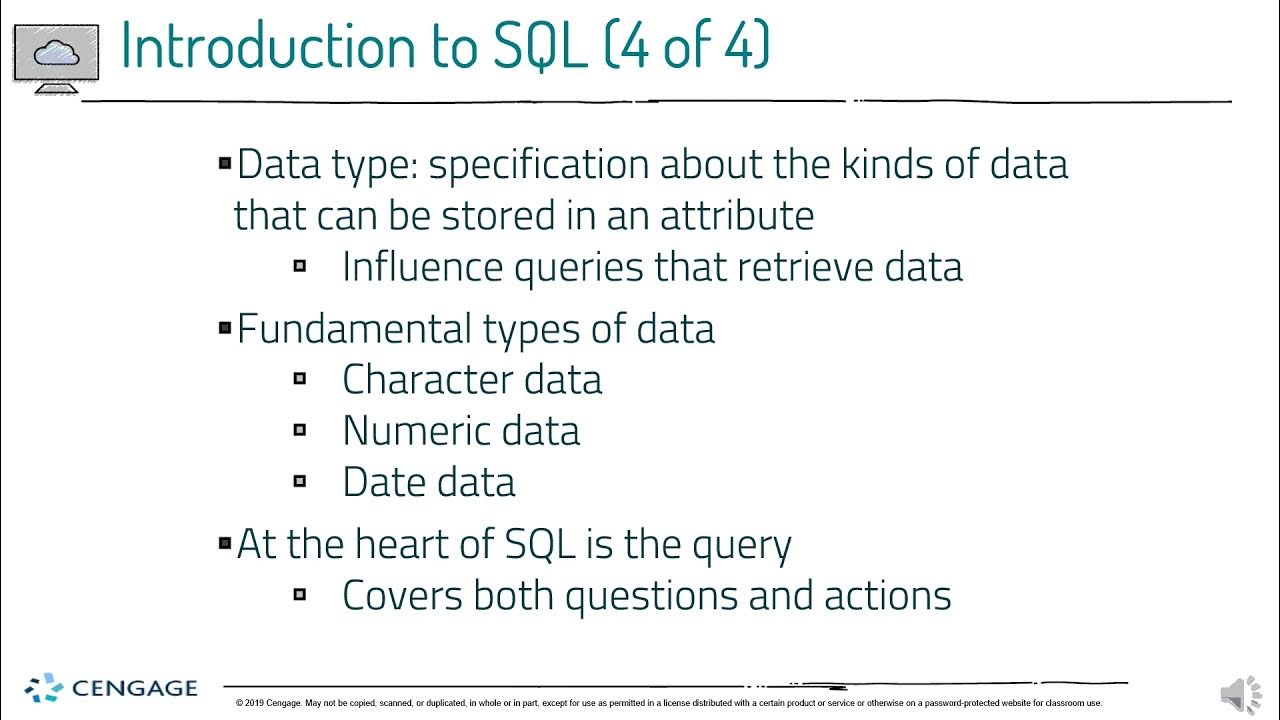Lec-52: Introduction to Structured Query Language | All Points regarding its Features and Syllabus
Summary
TLDRIn this educational video, the host delves into the basics of SQL, explaining its role as a structured query language for communicating with databases. They touch on SQL's history, starting with E.F. Codd's relational model in 1970, and IBM's development of SQL from SEQUEL. The script outlines SQL's features, including its domain-specific nature for relational databases and its declarative approach, contrasting with procedural languages. Key topics like DDL, DML, DCL, TCL, and concepts such as joins, nested queries, and PL/SQL are highlighted, emphasizing their importance for both competitive exams and professional placements.
Takeaways
- 😀 SQL stands for Structured Query Language, a language used for communication between users and databases.
- 📚 The concept of SQL originated in 1970 with E.F. Codd, who is known as the Father of DBMS, and his paper on the relational model.
- 🔍 SQL is a Domain Specific Language, designed for use within relational databases where data is structured and stored in tables.
- ✅ SQL is a Declarative Language, meaning users specify what they want to achieve rather than how to achieve it, unlike Procedural Languages.
- 🔑 The video emphasizes the importance of understanding SQL for competitive exams and job placements, highlighting its relevance in the tech industry.
- 📈 SQL's evolution has seen implementations by major companies like IBM, Oracle, and Microsoft, each with their own SQL-based database systems.
- 🌐 Today, SQL is part of a broader data management landscape that includes NoSQL and big data technologies, reflecting the shift towards unstructured data.
- 🛠️ The script covers SQL's basic operations like DDL (Data Definition Language), DML (Data Manipulation Language), DCL (Data Control Language), and TCL (Transaction Control Language).
- 🔍 The video discusses SQL operators and clauses, such as WHERE, GROUP BY, HAVING, and aggregate functions like COUNT, AVG, MAX, which are crucial for data retrieval and manipulation.
- 🔗 Emphasis is placed on JOIN and NESTED queries as a complex area where students often face difficulties, and it's a critical topic for both competitive exams and job placements.
- 📝 PL/SQL is introduced as an advanced SQL feature, allowing procedural programming within SQL to create triggers, functions, cursors, and procedures.
Q & A
What is SQL and why is it called a structured query language?
-SQL, which stands for Structured Query Language, is a domain-specific language used for managing and manipulating databases. It is called 'structured' because it deals with data that is organized in a fixed model, typically in tables or relations, hence the term 'structured data'.
Why is SQL considered a language for communication between users and databases?
-SQL serves as a language for communication because it allows users to interact with databases by sending queries to fetch, insert, update, or delete data. It is the medium through which users can communicate their data requests to the database management system.
Who is known as the 'Father of DBMS' and what contribution did they make to SQL?
-EF Codd is known as the 'Father of DBMS.' He published a paper on the relational model in 1970, which proposed storing data in tables. This foundational work led to the development of SQL as a language for managing relational databases.
What was the original name of SQL when it was first implemented by IBM, and why was it changed?
-The original name of SQL when first implemented by IBM was 'Simple English Query Language,' or SEQUEL. It was later shortened to 'SQL' to make the name more concise and universally recognizable.
How has the importance of SQL evolved over time with the rise of unstructured data?
-Initially, SQL was crucial for managing structured data in relational databases. However, with the rise of unstructured data, which now constitutes about 90% of the world's data, SQL's dominance has been challenged. Technologies like NoSQL, Big Data, Spark, and MongoDB have emerged to handle unstructured data, but SQL remains fundamental for structured data management.
What does it mean for SQL to be a Domain Specific Language?
-Being a Domain Specific Language means that SQL is designed for use within a particular domain, which in this case is relational databases. It is not a general-purpose language like C or C++ that can be used across various applications; instead, its use is specific to managing and querying structured data in relational databases.
Why is SQL classified as a Declarative Language?
-SQL is classified as a Declarative Language because it allows users to specify what they want to achieve ('what to do') without detailing the steps or algorithms ('how to do it'). The database management system then determines the most efficient way to perform the requested operations.
What is the significance of DDL, DML, DCL, and TCL in SQL?
-DDL (Data Definition Language), DML (Data Manipulation Language), DCL (Data Control Language), and TCL (Transaction Control Language) are categories of SQL commands used for different purposes: DDL for defining and creating database structures, DML for manipulating data, DCL for controlling access and setting permissions, and TCL for managing transactions.
Can you provide an example of how SQL is used in real-world applications like IRCTC?
-In real-world applications like the Indian Railway Catering and Tourism Corporation (IRCTC), SQL is used to manage and query a large database of train schedules and seat availability. Users can search for trains and seats on a particular date, and the system retrieves this information in a tabular format, which is a practical application of SQL's structured data querying capabilities.
What are the key topics that should be covered when learning SQL, according to the script?
-Key topics to cover when learning SQL include understanding DDL, DML, DCL, and TCL commands, working with keys and constraints (like primary and foreign keys), using SQL operators (such as BETWEEN, IN, NOT IN), mastering aggregate functions (like AVG, COUNT, MAX), and especially focusing on JOIN and nested queries, which are crucial for both placements and competitive exams.
What is PL/SQL and how does it differ from standard SQL?
-PL/SQL, which stands for Procedural Language/SQL, is an extension of SQL that includes procedural programming features. Unlike standard SQL, which is declarative and focuses on 'what to do,' PL/SQL also specifies 'how to do it,' allowing for more complex operations like creating triggers, functions, cursors, and procedures.
Outlines

Cette section est réservée aux utilisateurs payants. Améliorez votre compte pour accéder à cette section.
Améliorer maintenantMindmap

Cette section est réservée aux utilisateurs payants. Améliorez votre compte pour accéder à cette section.
Améliorer maintenantKeywords

Cette section est réservée aux utilisateurs payants. Améliorez votre compte pour accéder à cette section.
Améliorer maintenantHighlights

Cette section est réservée aux utilisateurs payants. Améliorez votre compte pour accéder à cette section.
Améliorer maintenantTranscripts

Cette section est réservée aux utilisateurs payants. Améliorez votre compte pour accéder à cette section.
Améliorer maintenantVoir Plus de Vidéos Connexes

What is Database & SQL?

SQL and its History - Structured Query Language | Class 12 Computer Science Chapter 9 | CBSE 2024-25

07 Introduction to SQL PART1

Relational Data Model in DBMS in Hindi | Advantages & Disadvantages - Lecture #5

SQL Basics for Beginners | Learn SQL | SQL Tutorial for Beginners | Edureka

SQL vs NoSQL in 2024 Make the Right Choice (Difference Explained)
5.0 / 5 (0 votes)
